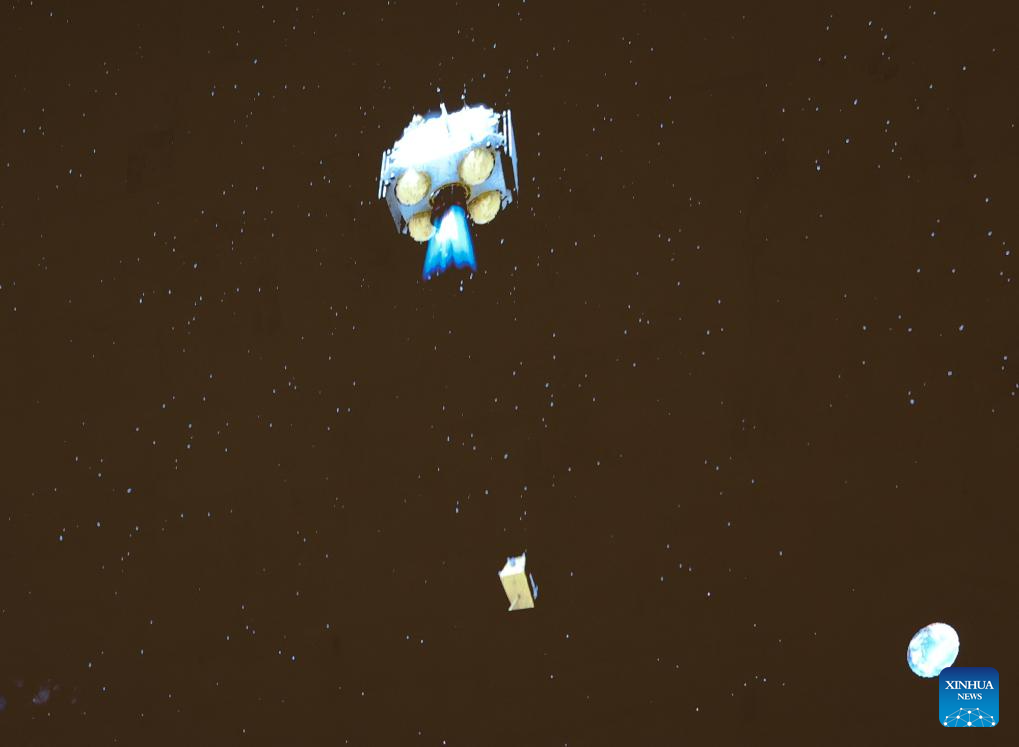Source:Xinhua 2024-06-04

This image taken from video animation at Beijing Aerospace Control Center (BACC) on June 4, 2024 shows the ascender of China's Chang'e-6 probe, carrying samples collected from the moon's far side, lifting off from lunar surface. The ascender has entered a preset orbit around the moon, said the China National Space Administration (CNSA). (Xinhua/Jin Liwang)
BEIJING, June 4 (Xinhua) -- The ascender of China's Chang'e-6 probe lifted off from lunar surface on Tuesday morning, carrying samples collected from the moon's far side, an unprecedented feat in human lunar exploration history.
The ascender has entered a preset orbit around the moon, said the China National Space Administration (CNSA).
The Chang'e-6 probe, comprising an orbiter, a lander, an ascender and a returner -- like its predecessor Chang'e-5 -- was launched on May 3. Its lander-ascender combination touched down at the designated landing area in the South Pole-Aitken (SPA) Basin on June 2.
The spacecraft finished its intelligent and rapid sampling work, and the samples were stowed in a container inside the ascender of the probe as planned, the CNSA said.
During sampling and packaging, researchers conducted simulated sampling in a ground lab, based on the detection data sent back by the Queqiao-2 relay satellite, providing important support for decision-making and operations in every link.
"The mission has withstood the test of high temperature on the far side of the moon," the CNSA said.
It adopted two methods of moon sampling, including using a drill to collect subsurface samples and grabbing samples on the surface with a robotic arm. It automatically gathered diverse samples at different sites.
The multiple payloads installed on the lander, including the landing camera, panoramic camera, lunar soil structure detector and lunar mineral spectrum analyzer, worked well and carried out scientific exploration as planned, the CNSA said.
The lunar soil structure detector analyzed and judged the underground lunar soil structure of the sampling area, providing data reference for the sample drilling.
After the sampling was completed, a Chinese national flag carried by the lander was unfurled for the first time on the far side of the moon.
Unlike takeoff on Earth, the ascender could not rely on a launch tower system. The lander acted as a temporary "launching pad."
The Chang'e-6 ascender's takeoff from the far side of the moon cannot copy the Chang'e-5 ascent from the near side of the moon, as it cannot directly receive ground control and support. It utilized its special sensors to achieve autonomous positioning and orientation, with the assistance of Queqiao-2 for communication.
Compared with Chang'e-5, Chang'e-6 has seen improvements in the autonomy and reliability of its navigation, guidance and control system, in order to tackle the challenges posed by the uncertainties of the moon's far side during its takeoff and ascent, said Qiao Dezhi, a space expert from the China Aerospace Science and Technology Corporation (CASC).
The control system of Chang'e-6 has also been enhanced to improve its autonomy, enabling it to complete lunar takeoff and ascent with reduced reliance on the Queqiao-2 relay satellite and ground support, said Huang Hao, another space expert from the CASC.

This image taken from video animation at Beijing Aerospace Control Center (BACC) on June 4, 2024 shows the ascender of China's Chang'e-6 probe, carrying samples collected from the moon's far side, lifting off from lunar surface. The ascender has entered a preset orbit around the moon, said the China National Space Administration (CNSA). (Xinhua/Jin Liwang)
Copyright © Xizang Daily & China Xizang News All rights reserved
Reproduction in whole or in part without permissions prohibited
Index Code: 藏 ICP 备 05000021 号
Producer: Xizang Daily International Communication Center